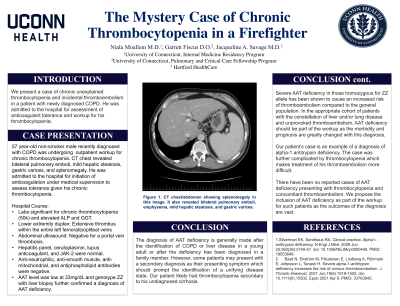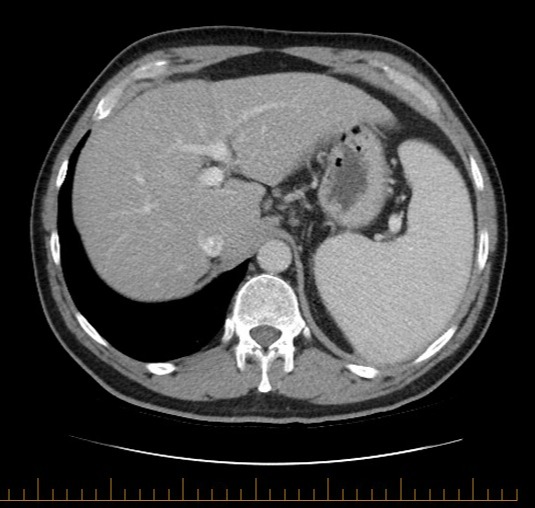Back


Poster Session A - Sunday Afternoon
Category: Liver
A0564 - The Mystery Case of Chronic Thrombocytopenia in a Firefighter
Sunday, October 23, 2022
5:00 PM – 7:00 PM ET
Location: Crown Ballroom

Has Audio

Niala Moallem, MD
University of Connecticut
Hartford, CT
Presenting Author(s)
Niala Moallem, MD1, Garrett Fiscus, DO2, Jacqueline A. Savage, MD3
1University of Connecticut, Hartford, CT; 2UCONN Health, Farmington, CT; 3Hartford Hospital, Hartford, CT
Introduction: We present a case of chronic unexplained thrombocytopenia and incidental thromboembolism in a patient with newly diagnosed chronic obstructive pulmonary disease (COPD). He was admitted to the hospital for assessment of anticoagulant tolerance and workup for his thrombocytopenia which resulted in the diagnosis of alpha-1 antitrypsin (AAT) deficiency.
Case Description/Methods: A 57-year-old non-smoker male recently diagnosed with COPD was undergoing workup for chronic thrombocytopenia. A computed tomography (CT) chest revealed bilateral pulmonary emboli, mild hepatic steatosis, gastric varices, and splenomegaly. He was admitted to the hospital for initiation of anticoagulation under medical supervision to assess tolerance given his chronic thrombocytopenia. On arrival, vitals were normal and labs were significant for a chronic thrombocytopenia, elevated ALP and GGT levels.
A lower extremity duplex revealed an extensive thrombus within the entire left femoral/popliteal veins. An abdominal ultrasound was negative for a portal vein thrombosis. Hepatitis panel, ceruloplasmin, lupus anticoagulant, and JAK-2 were normal. Anti-neutrophilic, anti-smooth muscle, anti-mitochondrial, and antiphospholipid antibodies were negative. AAT level was low at 33mg/dL and genotype ZZ with liver biopsy further confirming a diagnosis of AAT deficiency.
Discussion: The diagnosis of AAT deficiency is generally made after the identification of COPD or liver disease in a young adult or after the deficiency has been diagnosed in a family member. However, some patients may present with a secondary diagnosis as their presenting symptom which should prompt the identification of a unifying disease state. Our patient likely had thrombocytopenia secondary to his undiagnosed cirrhosis.
Severe AAT deficiency in those homozygous for ZZ allele has been shown to cause an increased risk of thromboembolism compared to the general population. In the appropriate cohort of patients with the constellation of liver and/or lung disease and unprovoked thromboembolism, AAT deficiency should be part of the workup as the morbidity and prognosis are greatly changed with this diagnosis. Our patient's case was further complicated by thrombocytopenia which makes treatment of his thromboembolism more difficult.
There have been no reported cases of AAT deficiency presenting with thrombocytopenia and concomitant thromboembolism. We propose the inclusion of AAT deficiency as part of the workup for such patients as the outcomes of the diagnosis are vast.

Disclosures:
Niala Moallem, MD1, Garrett Fiscus, DO2, Jacqueline A. Savage, MD3. A0564 - The Mystery Case of Chronic Thrombocytopenia in a Firefighter, ACG 2022 Annual Scientific Meeting Abstracts. Charlotte, NC: American College of Gastroenterology.
1University of Connecticut, Hartford, CT; 2UCONN Health, Farmington, CT; 3Hartford Hospital, Hartford, CT
Introduction: We present a case of chronic unexplained thrombocytopenia and incidental thromboembolism in a patient with newly diagnosed chronic obstructive pulmonary disease (COPD). He was admitted to the hospital for assessment of anticoagulant tolerance and workup for his thrombocytopenia which resulted in the diagnosis of alpha-1 antitrypsin (AAT) deficiency.
Case Description/Methods: A 57-year-old non-smoker male recently diagnosed with COPD was undergoing workup for chronic thrombocytopenia. A computed tomography (CT) chest revealed bilateral pulmonary emboli, mild hepatic steatosis, gastric varices, and splenomegaly. He was admitted to the hospital for initiation of anticoagulation under medical supervision to assess tolerance given his chronic thrombocytopenia. On arrival, vitals were normal and labs were significant for a chronic thrombocytopenia, elevated ALP and GGT levels.
A lower extremity duplex revealed an extensive thrombus within the entire left femoral/popliteal veins. An abdominal ultrasound was negative for a portal vein thrombosis. Hepatitis panel, ceruloplasmin, lupus anticoagulant, and JAK-2 were normal. Anti-neutrophilic, anti-smooth muscle, anti-mitochondrial, and antiphospholipid antibodies were negative. AAT level was low at 33mg/dL and genotype ZZ with liver biopsy further confirming a diagnosis of AAT deficiency.
Discussion: The diagnosis of AAT deficiency is generally made after the identification of COPD or liver disease in a young adult or after the deficiency has been diagnosed in a family member. However, some patients may present with a secondary diagnosis as their presenting symptom which should prompt the identification of a unifying disease state. Our patient likely had thrombocytopenia secondary to his undiagnosed cirrhosis.
Severe AAT deficiency in those homozygous for ZZ allele has been shown to cause an increased risk of thromboembolism compared to the general population. In the appropriate cohort of patients with the constellation of liver and/or lung disease and unprovoked thromboembolism, AAT deficiency should be part of the workup as the morbidity and prognosis are greatly changed with this diagnosis. Our patient's case was further complicated by thrombocytopenia which makes treatment of his thromboembolism more difficult.
There have been no reported cases of AAT deficiency presenting with thrombocytopenia and concomitant thromboembolism. We propose the inclusion of AAT deficiency as part of the workup for such patients as the outcomes of the diagnosis are vast.

Figure: CT Abdomen, axial view: Decreased density of liver relative to the spleen is suggestive of hepatic steatosis. Splenomegaly present.
Disclosures:
Niala Moallem indicated no relevant financial relationships.
Garrett Fiscus indicated no relevant financial relationships.
Jacqueline Savage indicated no relevant financial relationships.
Niala Moallem, MD1, Garrett Fiscus, DO2, Jacqueline A. Savage, MD3. A0564 - The Mystery Case of Chronic Thrombocytopenia in a Firefighter, ACG 2022 Annual Scientific Meeting Abstracts. Charlotte, NC: American College of Gastroenterology.
